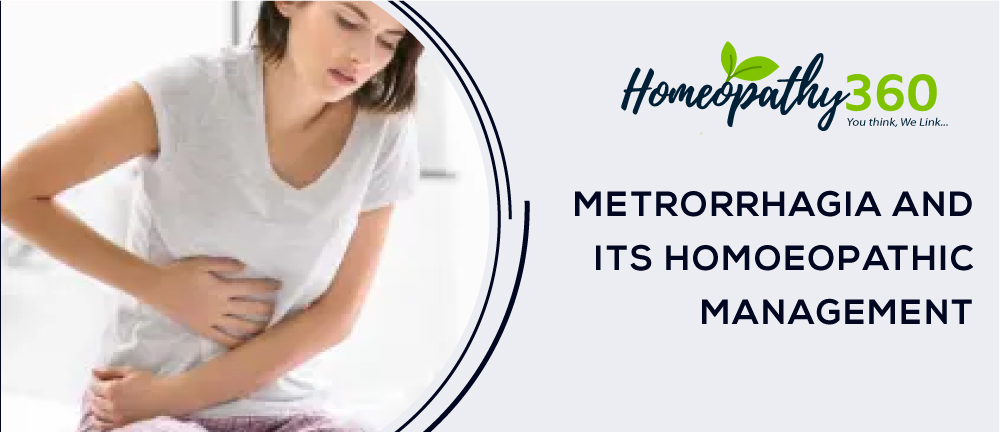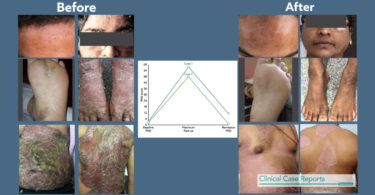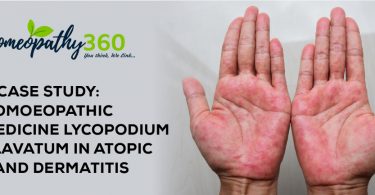
Metrorrhagia and Its Homoeopathic Management
ABSTRACT- To determine the clinical characteristics of metrorrhagia and its treatment, depending on severity; to evaluate the frequency of etiologies and to describe severe metrorrhagia. This article deals with an overview of metrorrhagia, focusing upon its various aspects along with Homoeopathic management.
KEYWORDS– Metrorrhagia, Homoeopathy
INTRODUCTION– Metrorrhagia is now commonly called as inter menstrual bleeding, vaginal bleeding that occurs at irregular intervals that is not associated with the menstrual cycle. The blood comes from the uterus as it does during menstruation but the bleeding does not represent a normal period. There are many causes of metrorrhagia, some of them are harmless. While in other, metrorrhagia can be a sign of a more serious condition.
SYMPTOMS–
The commonest symptom of metrorrhagia is irregular vaginal bleeding. Excessive menstrual bleeding is usually associated with bleeding at puberty. In the first two years of menarche, irregular menstruation occurs in 2-5 percent of adolescents. It occurs due to the cycles without ovulation. Hence, in the first phase of the cycle under the influence of estrogen, the growth of the endometrium that took place might not be balanced with that of the second phase of the cycle, wherein there is a usual increase in progesterone. These following symptoms may or may not be experienced:
- Abdominal pain or cramps
- Light to heavy menstrual bleeding
- ectopic pregnancy or miscarriage
CAUSES–
Endometrial Hyperplasia
Ruptured Polyps
Uterine Cancer
· Cervical Dysplasia
· Abortion or Miscarriage
· Cervicitis
· Hormonal Imbalance
· Infection
· ITP
· Use of Contraception
· Cervical cancer
· Vaginal cancer
· Ovarian cancer
· Primary fallopian tube cancer
· Vulvar cancer
· Endometrial cancer
OTHER CAUSES
- Presence of fibroids
- Cervical ectopy or erosion
- Endometriosis
- Uterine adhesions
- Thyroid disorders
- Taking blood thinners
- Stress
RISK FACTORS
- History of recent abortion (if any)
- Users of contraceptives such as pills or IUDs
- Pregnancy
- History of sexual activity
- Diet
- Any medical conditions in the past
DIAGNOSIS
- Endometrial Biopsy
- Ultrasound Scan
- Hysteroscopy
- Sonohysterogram
HOMOEOPATHIC MANAGEMENT-
- Aletris farinose: Marked anaemia, relaxed condition, especially of the female organism, is portrayed by this remedy. The patient is tired all the time. Premature and profuse menses, with labor-like pains. Uterus seems heavy.
- Apocynum cannabinum: Profuse bleeding with bloating; nausea; fainting, vital depression. Haemorrhages at change of life. Blood expelled in large clots. Use tincture ten drops three times daily.
- Aranea diadema: Menses too copious, too early with distention of abdomen and lumbo-abdominal neuralgia.
- Cannabis indica: Menses profuse, dark, painful, without clots. Backache during menses. Uterine colic, with great nervous agitation and sleeplessness.
- Caulophyllum: This is a woman’s remedy who want tonicity of the womb. Thrush, locally and internally. Extraordinary rigidity of os. Moth-spots on forehead. Menses profuse and protracted with great atony.
- Cinnamonum ceylanicum: Menses early, profuse, prolonged, bright red. Sleepiness marked. No desire for anything. Uterine haemorrhages, caused by overlifting.
- Crocus sativus: Menorrhagia especially when haemorrhage is dark and stringy. Urging of blood to genitals. Menses dark, viscid, too frequent and copious, black and slimy. Uterine haemorrhage; clots with long strings; worse from least movement.
- Erigeron canadense: Haemorrhages are cured by this remedy. Persistent haemorrhage from the uterus, with painful micturition. Profuse bright-red blood. Menorrhagia; returns after least motion, comes in gushes; with urinary irritation.
- Fraxinus americana: Enlargement of the uterus. Fibrous growths, subinvolution, and prolapse. Heavy uterine bleeding with bearing-down sensations; worse in afternoon and night.
- Geranium maculatum: Habitual sick headaches. Profuse bleeding. Menses too profuse. Indicated in females with sore nipples.
- Hamamelis virginiana: Ovarian congestion and neuralgia; feel very sore. Menorrhagia with bearing-down pain in back. Menses dark, profuse, with soreness in abdomen. Intermenstrual pain. Vagina very tender with itching.
- Helonias dioica: Menses with dragging in sacral region, with prolapse. Pruritus vulvae. Menses too frequent, too profuse. Debilitating menses.
- Millefolium: Menses early, profuse, protracted. Haemorrhage from uterus; bright red, fluid.
- Sabina: Menses profuse, bright. Uterine pains extend into thighs. Menorrhagia in women who aborted readily. Pain from sacrum to pubis, and from below upwards shooting up the vagina. Haemorrhage; partly clotted; worse from least motion. Atony of uterus.
- Senecio aureus: Suited to young girls with backache. Premature and too profuse menses.
- Thlaspi bursa pastoris: Haemorrhage, with violent uterine colic. Every alternate period very profuse. Scarcely recovers from one period before another begins.
- Trillium pendulum: Uterine haemorrhages, with sensation as though hips and back were falling to pieces; better tight bandages. Menorrhagia with gushing of bright blood on least movement.
- Ustilago maydis: Profuse menses; discharge of blood from slightest provocation; bright red; partly clotted. Ovaries burn, pain, swell. Oozing of dark blood, clotted, forming long black strings. Uterus hypertrophied
CONCLUSION– The most common cause of metrorrhagia is a functional disorder. Hemostatic disorders likely to cause severe menstrual hemorrhage were known before the age of menarche; these disorders must be controlled before or at the time of the first menstrual period. Severe forms that arise during the initial three menstrual cycles are in most cases functional, such cases should be given a course of treatment lasting several years. There is a high risk of recurrence. Treatment of the causes of metrorrhagia can be effective as in allopathy they use OCP to control bleeding in such cases which is immense harmful to the body for long term consumption whereas Homoeopathic Materia-medica is enriched with many similar such symptoms in their remedies with minimal harmful effects to the human body, so their effectiveness has to be explored further to relief the suffering of mankind as well as research perspective to enrich the homoeopathic literature in all possible ways.
REFERNCES–
1. Konar Hiralal. DC Dutta’S Textbook of Gynaecology, 7th Edition, Jaypee, 2013.
2. Medical management of menstrual disorders
2004, International Congress Series
3. Abnormal uterine bleeding in adolescents
2003, Journal of Midwifery and Women’s Health
4. Clarke JH. A Dictionary of Practical Materia Medica. New Delhi: B. Jain Publishers, 1999
5. Boericke W. Pocket Manual of Homoeopathic Materia Medica and Repertory. 9th Edition. New Delhi: B. Jain Publishers (P) Ltd, 2009.
6. Kent JT. Lectures on Homoeopathy Materia Medica, New Delhi: B. Jain Publishers (P) Ltd, 2013.
7. Allen HC. Keynotes and Characteristics with Comparisons of some of Leading Remedies of the Materia Medica. 4th Edition. Philadelphia, Pa
8. Nash E. B. Leaders in Homoeopathic Therapeutics. B. Jain Publishers (P) Ltd, 1986
About Author:
DR. ASHOK YADAV, (H.O.D. PRACTICE OF MEDICINE),
DR. VIRENDRA CHAUHAN, (ASS.PROF. PRACTICE OF MEDICINE)
DR. ANANDITA DEBNATH (M.D. PGR, PRACTICE OF MEDICINE)





